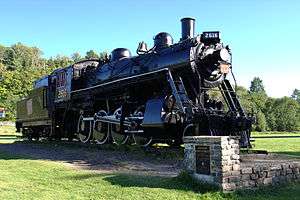Canadian National class N-4 2-8-0
Canadian National class N-4|

Canadian National Railways N4A locomotive on display at Head Lake, Haliburton, Ontario |
| Type and origin |
|---|
|
References: | | Power type |
Steam |
|---|
| Builder |
|
|---|
| Build date |
August 1906 – November 1911 |
|---|
| Total produced |
232 |
|---|
|
|
|
|
|
| Career |
|---|
| Operators |
|
|---|
| Class |
- GT: D2 through D7, D9 and D11
- CN: N-4-a through N-4-f
|
|---|
| Retired |
1952–1960 |
|---|
|
Canadian National Railway (CN) Class N-4 steam locomotives were of 2-8-0 wheel arrangement in the Whyte notation, or 1′D in UIC classification. These locomotives were built for the Grand Trunk Railway (GT) from 1906 until GT began purchasing class S freight locomotives in 1913. Class N-4 were built as Richmond compound locomotives with 210 lbf/in2 (1.4 MPa) boilers feeding 22 1⁄2 inches (572 mm) and 35 inches (889 mm) by 32 inches (813 mm) cylinders; but most had been rebuilt as simple single expansion locomotives by GT. The most satisfactory rebuilding method was designated sub-class N-4-a by CN, and lesser numbers of sub-classes N-4-b through N-4-f represent alternative rebuilding designs. Both GT and CN took some of these rebuilding efforts out of their original numerical sequence. CN numbered class N-4-a locomotives from 2525 through 2660 and numbered the alternative rebuilding classes from 2661 through 2686. The rebuilt simplified locomotives remained in freight service until the final replacement of steam with diesel locomotives.
Number 2534 was preserved in Zwick Island Park, Belleville, Ontario (moved to Memory Junction Railway Museum in Brighton, Ontario in 1997[3]); number 2601 in the Canadian Railway Historical Association Museum at Delson, Quebec; and number 2616 by the Kiwanis in Haliburton, Ontario.
| Builder |
Works numbers |
Dates |
GT numbers |
CN numbers |
Notes |
|---|
| MLW |
39548–39562 |
1906 |
651–665 |
2515–2529 |
|
| MLW |
40583–40622 |
1906 |
666–705 |
2530–2543, 2661, 2544–2551, 2662, 2552–2566, 2663 |
|
| ALCO |
42046–42060 |
1907 |
706–720 |
2669, 2567–2570, 2670–2671, 2571–2573, 2664, 2672, 2574–2576 |
built at ALCO's Schenectady Works |
| MLW |
42331–42345 |
1907 |
721–735 |
2577-2784, 2685, 2585–2590 |
|
| MLW |
43150–43164 |
1907 |
736–750 |
2591–2605 |
|
| ALCO |
43540–43554 |
1907 |
751–765 |
2606, 2673, 2607–2608, 2674, 2609–2610, 2675, 2611–2612, 2676, 2613, 2665, 2614–2615 |
built at ALCO's Schenectady Works |
| MLW |
45163–45182 |
1908 |
631–650 |
2627–2646 |
|
| MLW |
46880-46894 |
1910 |
616–630 |
2647–2657, 2686, 2658–2660 |
|
| ALCO |
49663–49674 |
1911 |
766–777 |
2677, 2616–2623, 2678, 2624–2625 |
built at ALCO's Brooks Works |
| ALCO |
50472–50481 |
1911 |
779–787 |
2679, 2666, 2626, 2680–2682, 2667, 2683, 2668, 2684 |
built at ALCO's Schenectady Works |
References
- Clegg, Anthony; Corley, Ray (1969). Canadian National Steam Power. Montreal: Trains & Trolleys.
- Edson, William D.; Corley, Raymond F. (Autumn 1982). "Locomotives of the Grand Truck Railway". Railroad History. The Railway & Locomotive Historical Society, Inc. (147). ISSN 0090-7847.
